By R.G. Singh
An ancient Indian sartorial tradition for a man of social standing was donning a turban. The widely practised custom was prevalent among many classes of society and continues in select regions even to this day. Most of these headgears are plain in appearance shielding the wearer against the tropical sun.
While some are worn as an important accessory asserting social status as the occasion demands, others are a necessity as the particular religion demands the practice. A majority of turbans consist of a gossamer thin cloth which is skilfully tied by the wearer while gripping one end of the cloth with his teeth.
Elaborate headgear with tufts at both ends requires the assistance of a professional turban tier. Another variety of turban is the one that is already tied, the layers are stitched and placed on the head like a hat.
Turban Trail
The Mysore turban (Mysore peta) has a visual recorded history since 1799, the year HH Krishnaraja Wadiyar III (KRW III) aged 5 years was placed on the throne of Mysore.
The devotional images of the earlier Wadiyar kings carved in stone as seen at the Trineshwara Temple are shown with the hair tightly tied in a cloth in a side bun (turubu) (Fig. 10). However, painted portraits of the early Wadiyar kings are shown in Mysore turbans at the Chitramantapa – Subbarayadasa Temple which was painted during the reign on KRW III.
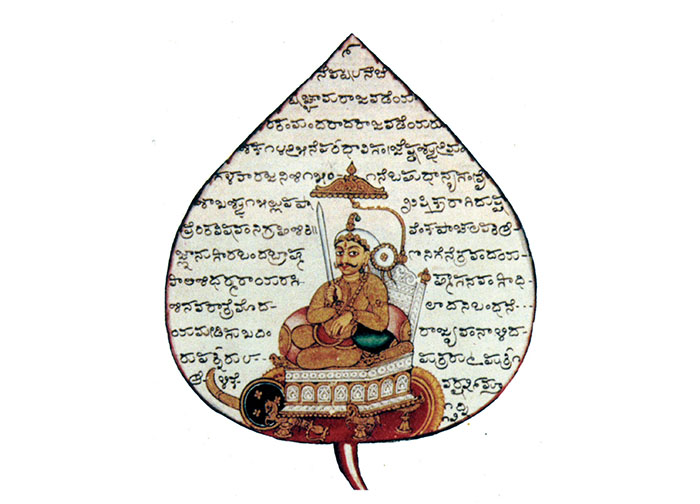
An oil painting by Thomas Hickey which is on display at the Rashtrapati Bhavan depicts a portrait of a boy king in a circular turban (Fig. 1). The legend below reads Krishnaraja Wadiyar III at his installation. Similar turbans can be seen in the painting wherein two young sons of Tipu Sultan are being handed over to the officials of the East India Company as hostages. All Indians are depicted wearing circular turbans.
It is only later in the official portraits from 1820s of KRW III, the appearance of a distinct Mysore turban is seen (Fig. 2). Over the years, portrait paintings by the gifted artists in the Mysore atelier record the emergence of the Mysore turban as it is recognised today.
Among the last four rulers of the Wadiyar dynasty, KRW III is seen in innumerable paintings sporting a variety of large turbans which differ in shape or style. This gives us a clue that the turban was mostly tied as a daily routine. It is mostly in coloured lithographs which form the frontispiece of his books that the king is shown in the same type of an elegant, a ready-to-wear turban which was tied beforehand and the folds hand-stitched to stay in shape (Fig. 3).
KRW III can be considered a trendsetter who experimented with the Mysore turban. Murals at the Jaganmohan Palace depict many of his important courtiers in a variety of colourful turbans. An album in a personal collection containing painted folios of the persons employed at the palace depicts many in turbans. What is of importance is that each portrait has a legend identifying the name of the person and the nature of his job.
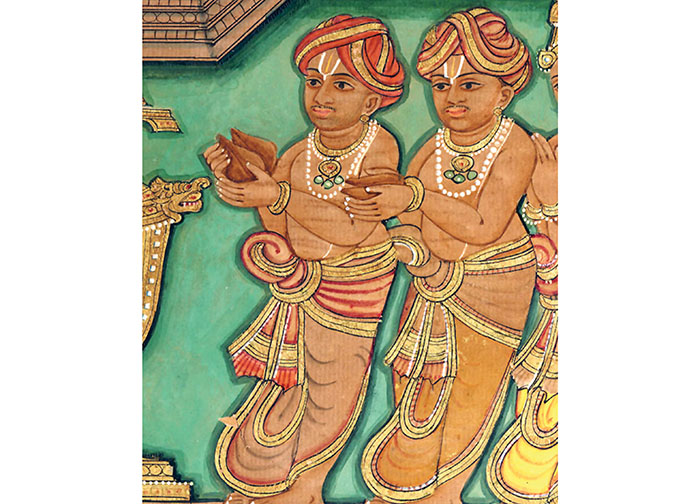
In an official portrait (Fig. 12), the young Maharaja HH Chamarajendra Wadiyar (CRW) is seen being heavily weighed down by the turban and its jewellery. In an oil painting by Raja Ravi Varma done a few years later, the handsome Maharaja looks dapper and elegant in a similar bejewelled turban. In another striking portrait by the same artist, CRW is shown wearing a royal blue coloured turban with jari patterns matching his close-collar coat (Fig. 5).
In another painted photograph, the Maharaja is seen wearing a Rajput-style angarkha (Fig. 4), a necklace of two strands, a pair of diamond ear studs and two rows of clasped collets ending with a bunch crossing the chest from left to right. The refinement of the dress is matched by a tastefully tied turban.
The two jari borders overlap each other instead of crisscrossing. The picture is a perfect example of exquisiteness. It is only in the headgears of this particular king that one sees, he was bold enough to experiment with textiles having polka dots, zigzag lines, chequered boxes, pinstripes, etc. He was undoubtedly flamboyant when he showed off the headgear.
When one examines the photographs of the next Maharaja HH Krishnaraja Wadiyar IV (KRW IV) and his brother Yuvaraja HH Kanteerava Narasimharaja Wadiyar (KNRW), the difference in the headgear is strikingly evident. While the Maharaja’s turbans are of the classical ready type (Fig. 7 & 8), the Yuvaraja chose a separate style of turban which was mostly tied (Fig. 9).
In the earlier pictures of KRW IV, he is seen in a variety of turbans with dazzling jewellery, especially his wedding portrait by Raja Ravi Varma. After 1927, the year that commemorated the silver jubilee of his coronation, he chose a modish headgear which was broader at the crown, a prominent jari band which added a courtly elegance but was shorn of all grandeur. In sharp contrast, his younger brother is mostly seen in the headgear type of the present-day Kalyana Karnataka region. To date, it is popular amongst wrestlers, especially during Dasara.
In fact, in the year 1895, in a sepia-toned photograph of the two brothers (Fig. 6), the Maharaja designate is seen in a Mysore turban while the Yuvaraja designate is seen in one that is not from the Mysore region. In signed official portraits of the Yuvaraja, he is mostly seen in Jodhpuri coats, western suits with ties or bows but with his usual non-Mysore-type turban (Fig. 9).
The last Maharaja HH Jayachamarajendra Wadiyar (JCW) was photographed extensively in his lifetime.
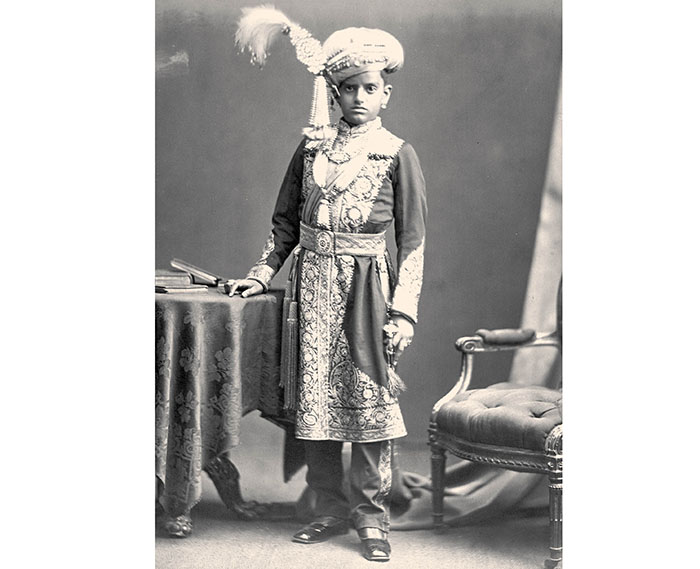
In one early photograph of his Upanayana, he is pictured in the regular Mysore turban, a 1938 picture of the Kashi Yatre ritual of his wedding (Fig. 13), and he is sporting a tied turban rarely seen later in public. In his graduation picture (Fig. 14), the young prince complements his western suit with a chic Mysore turban.
In the 1940 coronation pictures, the Maharaja is seen in all opulent finery. The select jewellery and headgear give one a peek into the celebration and the lavishness associated with the event.

A 1945 official portrait (Fig. 15) of the Maharaja in GCSI (Knight Grand Commander of the Most Exalted Order of the Star of India) robes, he sports a finely shaped Mysore turban which has a bejewelled Gandabherunda brooch at the apex topped with an Osprey tuft, perhaps signifying that the emblem of his state was above the medallion pinned to his tunic by the powers to be — British.
Later on, as the Raja Pramukh and Governor of Mysore and Madras States, the Maharaja is mostly seen in grey, white or cream-coloured long coats complemented by flamboyant turbans minus the jewellery.

Turban Torment
Archival records pertaining to the Dasara durbars and birthday celebrations (of the king) at the palace list out strict guidelines in the invitations for the dress code to be followed, the colour of the coat and trousers, length and width of the sash is specifically mentioned and of course the mandatory turban. Only the visiting dignitaries were spared the ordeal.
However, it is learnt that invited musicians, especially from Tamil Nadu, found the dress code with the turban, quite uncomfortable. From correspondence addressed to the Durbar Bakshi, a few of the musicians sought exemption from the rule stating that traditionally the Ghatam players performed bare-chested, but as correspondence and photographic evidence suggest, the request was turned down and nobody was given permission to enter the Durbar sans the prescribed attire.
The Mysore turban has gained much importance as it is presented to visiting dignitaries to the State. It is mandatory to be given at all State award presentations like the Rajyotsava and various honours given by the academies on behalf of the Government of Karnataka.
Abbreviations
Maharaja HH Krishnaraja Wadiyar III (KRW III)
Maharaja HH Chamarajendra Wadiyar X (CRW)
Maharaja HH Krishnaraja Wadiyar IV (KRW IV)
Yuvaraja HH Kanteerava Narasimharaja Wadiyar (KNRW)
Maharaja HH Jayachamarajendra Wadiyar (JCW)
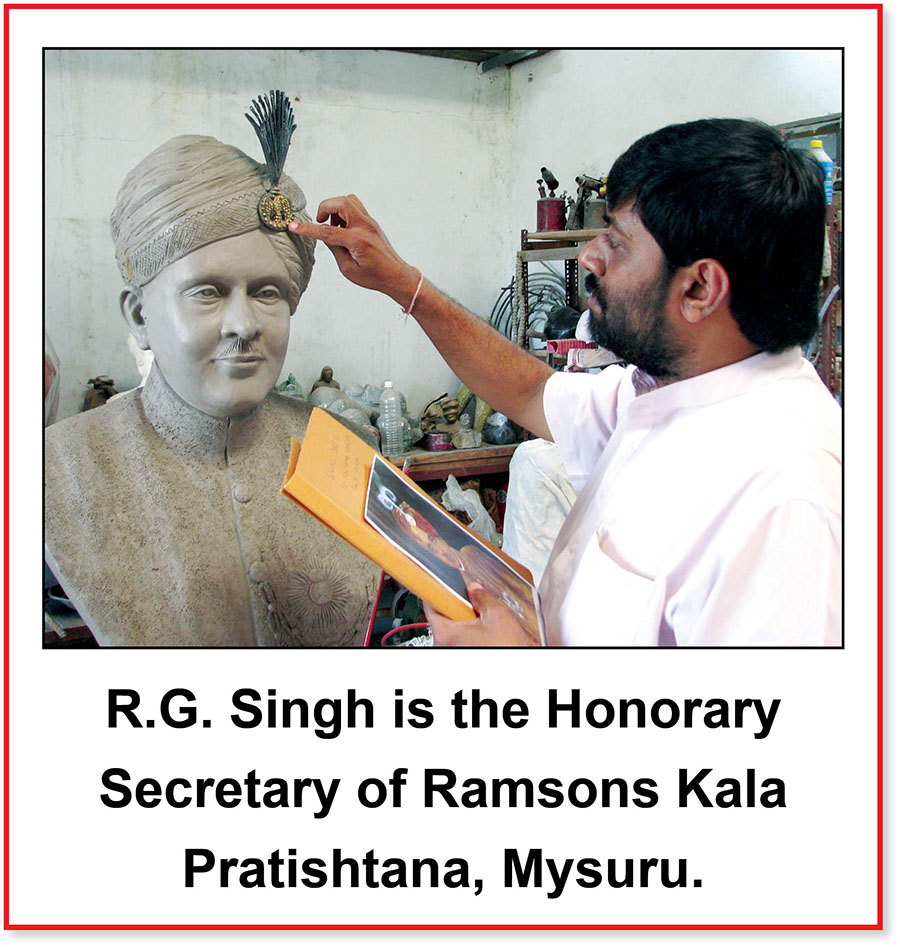
R.G. Singh is the Honorary Secretary of Ramsons Kala Pratishtana, Mysuru.



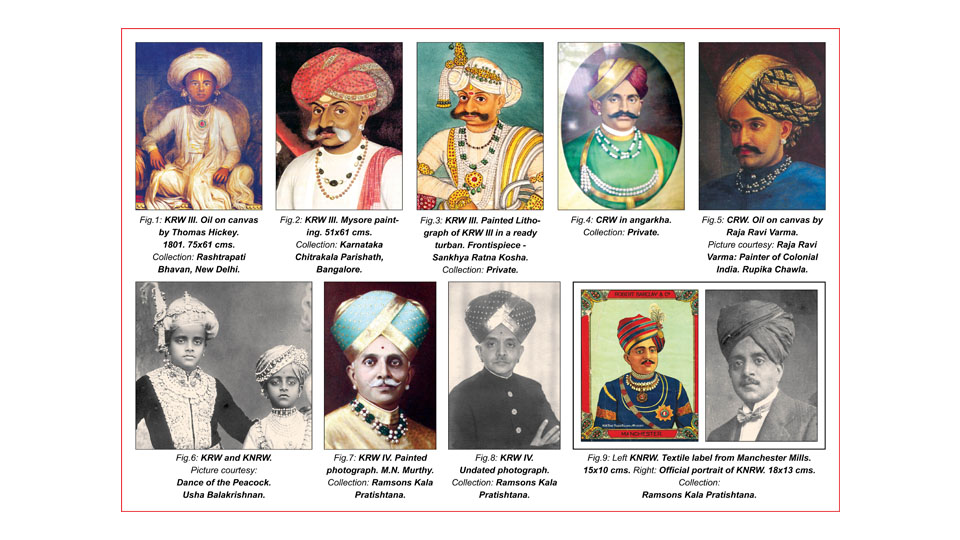




It was during the Durbar days of Wadiyars, the attendees, except the Europeans who wore suits, had to wear the so called Durbar Dress with Turbans perched on their heads.
There was another reason for turban -wearing of Wadiyars-to hide their baldness!
One could see every one in Jayachamaraja Wadiyar’s time-when he was doing his Durbar and acting as though he was still a Maharaja during 1950s,when the Royalty was removed by Patel, meeting him wearing a turban-even the traditional pundits-like astrologers, purohits etc… with turbans perched uncomfortably on their heads meeting this Maharaja, who had the tendency to call them all times of the day-particularly during nights! An astrologer who I know, a traditional Vedic scholar, rushing to the Palace at midnight to see His Highness , who summoned him. The reason-His Highness stumbled on his way to the bathroom, which he thought was due to a wrong placement of planets in his horoscope. The astrologer later , after his retirement from the Palace duties, laughingly said, the stumble was because His Highness had too much alcohol in his system! But, he said , he advised His Highness a Homa to set right the placement of planets in his horoscope.
Turbans are itchy, collect sweat and on the whole are meant to hide something on heads-usually hair loss, or blemishes in the scalp!
The Muslim rulers of India from the Mughals to Tipu Sultan worse turbans to show their power!
What is missing in this interesting article, is the turban Narendra Modi wears, when speaking from the Red Fort on the independence day or on the Republic day.
Modi wears a Marwari Turban, the kind of turban Marwari loan sharks wear, with a cane in their hands, so that they can create fear in their victims-the borrower to who the y lent money with a very hefty interest!
A good article by Mr. Singh on Wadiyars ‘ turbans. though he has missed out a few points, probably for lack of space. One or two photos are rare as well.Congratulations Mr Singh.
Mysore Peta with its gold lace was seen as a symbol of scholars erudition as most Indian professors in Maharajas’s College or elsewhere wore turbans, The ridiculous thing these days is putting the turban on women too, when they are felicitated, an idiotic approach!
The other version of the scholarly turban was plain turban with no gold laces, not exactly Mysore Peta, the Tamil Nadu version, worn by Sir CV Raman, Sir ASarvepalli Radhakrishnan, Sir A Ramaswamy Mudaliar, the Dewan of Mysore and his twin brother Sir A Lakshmanaswami Mudaliar, the Madras University Vc and famous Gynaecologist ,VS Sreenivasa Shastry, the English scholar, orator and the the educator , and Sir Sir Alladi Krishnaswamy Iyer, the famous Jurist who wrote the Indian constitution clauses.
Radhakrishnan took off his turban while on visits to Western countries and so was Nehtru without his cap when attending the Commonwealth Conferences, in the earlier days of independence.